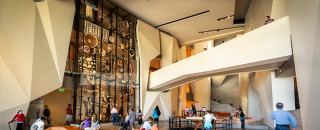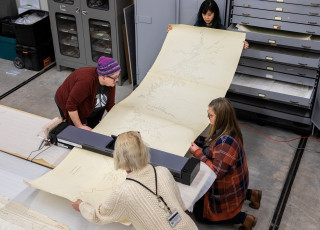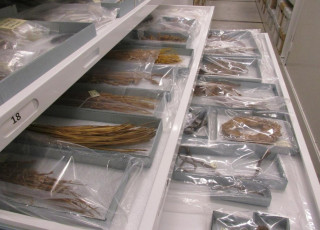In with the New: Our Collections Wall Gets a New Look
By Michael Mozdy
It’s one of the defining indoor features of the Natural History Museum of Utah: spanning three floors, the 36-foot Collections Wall displays 600 artifacts to guests as they enter the great canyon for the museum experience.
“It’s an opportunity to show the diversity of our collections in a beautiful way,” claims Tim Lee, NHMU’s Senior Exhibit Designer. While our exhibit halls allow visitors to dive into the science of our objects, the Collections Wall is about instilling wonder.
Five years after opening our new location, we’re making changes to our iconic Collections Wall.
Our changes will accomplish two things. First, light-sensitive objects like the textiles in our anthropology collection need to be put back in our collections cabinets so that they are not damaged. Second, we will be able to highlight some other collections and refresh our visitor experience, just in time for our 5-year anniversary in our new building.
The Jenga of the Wall
It’s not as easy as just taking out a few objects and inserting a few others. “It’s kind-of like Jenga – precarious. We don’t want to gamble with these objects, so, if you move one, the others around it need to move,” asserts Lee. The NHMU Exhibits team came up with a logistical plan to safely and securely move all of the objects out and then back in according to a new design.
The objects have to be removed from the ground-up and put back in from the top down. The reason for this is to keep any objects from falling on top of others in the process. In another game analogy, think about pachinko, where a ball at the top bounces from pin to pin all the way down to the bottom. That’s the worst-case scenario if done wrong, where hundreds of priceless objects could be damaged.
In anticipation of this removal of objects and replacement with a new design, we've placed a decal over the front face of the Collections Wall. It will stay in place until the new design is unveiled in mid-November, 2016. Below is a time-lapse video of the decal application.
Lee was responsible for the design of the first Collections Wall and now this refreshing of the display. “We decided to retain the core of the wall, the dynamic swirl of projectile points, pottery shards, and butterflies that so engages visitors,” he explains. Much of the paleontology material will also remain, but visitors will see more emphasis on parts of collection we haven’t highlighted thus far: specifically our vertebrate and plant collections. We’ll display skulls of elk, deer, bison, bighorn sheep, moose, three jars of “wet” vertebrate specimens, and several different plant specimens.
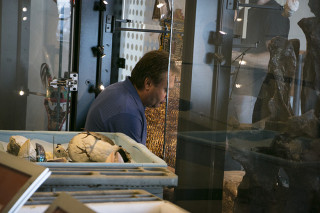
The Soul of NHMU
Lee becomes downright mystical when he discusses the objects. “Our collections represent the soul of the institution,” he says. “The objects have an ability to tell stories, tie us to the past, connect us in the present, and let us envision the future. That is their power.”
Importantly, the Collections Wall bridges the area where our researchers study our artifacts in the north side of the Rio Tinto Center and the interactive exhibits in the south side where our visitors can interface with them. The Collections Wall’s strategic position in the building highlights that it is through both their study and their public display that NHMU provides a vital resource as the official natural history museum for the state of Utah.
We thank our incredible Exhibits team, skilled not only in design, but in the manufacture of nearly invisible mounts for our artifacts, the creation and execution of incredible interactive displays, and the maintenance of all exhibits for the enjoyment of all of our guests.
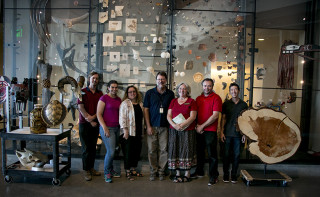
Michael Mozdy is a Digital Science Writer for The Natural History Museum of Utah, a part of the University of Utah in Salt Lake City. Our mission is to illuminate the natural world and the place of humans within it. In addition to housing outstanding exhibits for the public, NHMU is a research museum. Learn more.
